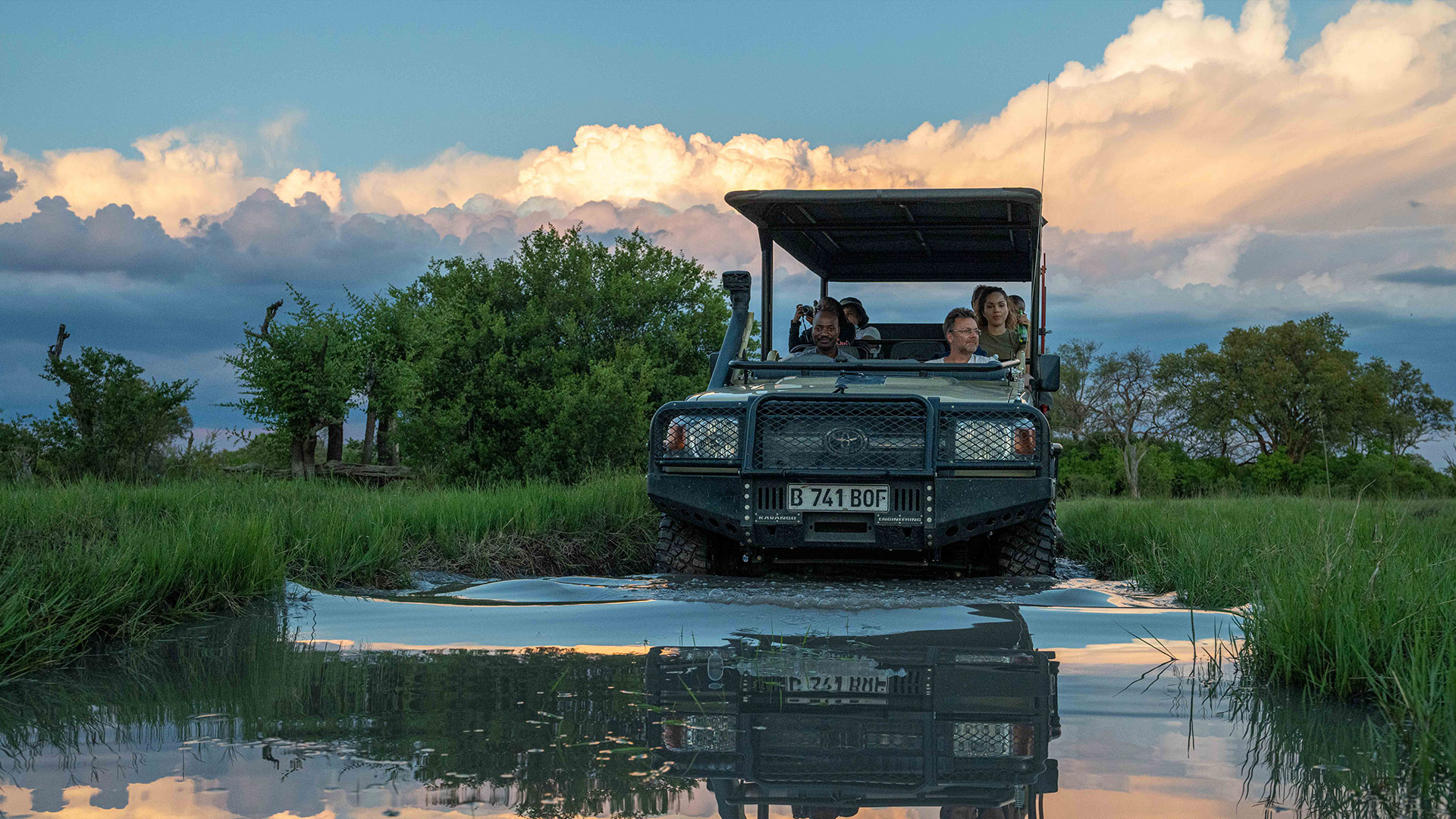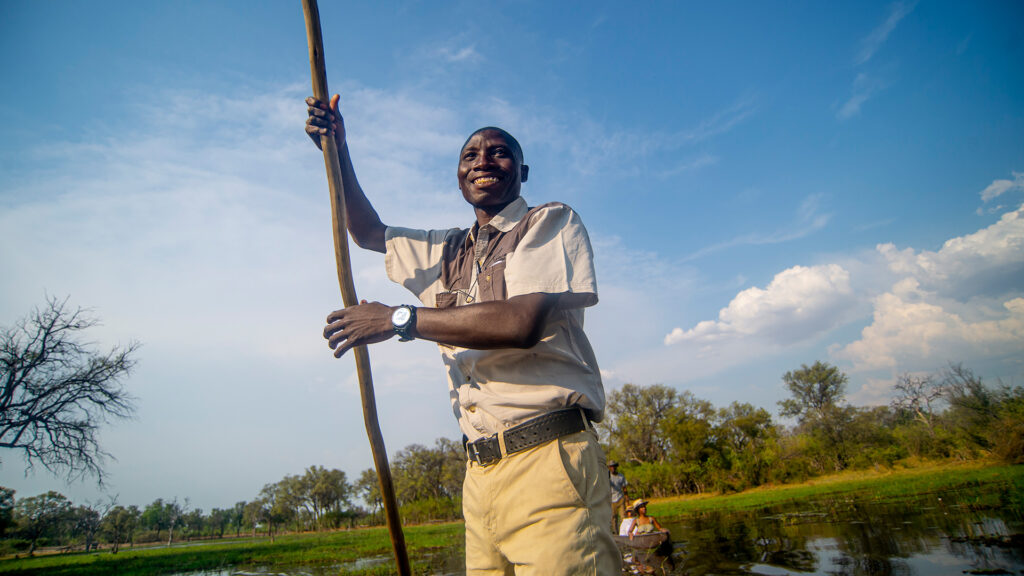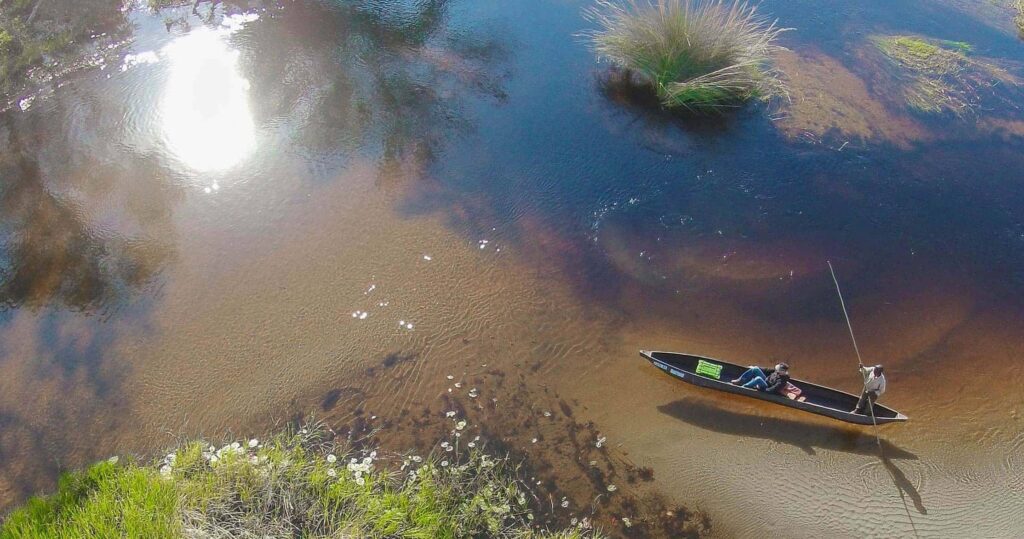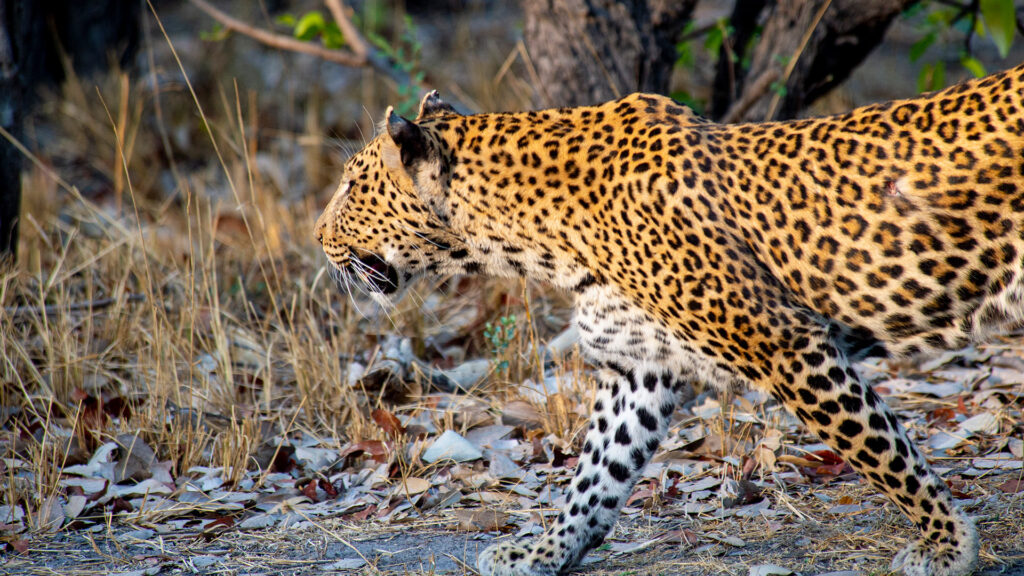Visiting the Moremi Game Reserve is an experience like no other. It captures the full range of elements that make Botswana a magical destination for travelers around the world: beautiful, ever-changing scenery, incredible animal and bird sightings, and warm hospitality from locals.
This remarkable landscape changes dramatically with the seasons, making it possible for travelers to come at any time and be delighted by something new.
A visit to the Moremi Game Reserve is so much more than a hunt for the Big Five. In addition to possibly seeing wild animals (which is a huge draw), you can appreciate breathtaking sunsets, canoed down lily-padded waterways, and take in expansive African skies while breathing in a warm African breeze.
Whether it’s your first or fourth time visiting Botswana – you can always expect something new and wonderful in Moremi!
In this blog we look at the best time to visit Moremi, going over all the months of the year.
Green season

January
During the rainy season in January, the Moremi Game Reserve becomes lush with green vegetation and clear air, providing ideal conditions for photography. Although the large herds of animals have migrated, there are still various species including lion, leopard, wild dog, buffalo, and elephant bulls.
There is a variety of young plains wildlife, resulting in interesting predator/prey interactions. The month of January is favorable for birdwatching, as the migratory birds display their breeding plumage in full at this time of year.
The days are hot and humid. There are occasional thunderstorms. When it rains, the temperatures drop making the place a bit cooler. The daily temperatures range from low 20°C to low 30°C. Be sure to pack a light fleece or rain jacket to be ready for the cooler temperatures. January, February, and March are the wettest months in the year.
February
February is the rainy season in the Moremi Game Reserve. The vegetation is green and the air is clear giving you some of the most beautiful scenery of the reserve. This makes it great for photography. The large herds of animals that would be usually present in the dry season are gone, but there are still lions, leopards, wild dogs, buffalo, and elephant bulls who are residents in this area. There are also young plains wildlife for predator/prey interactions. January is good for birding.
The days are hot and humid. Occasionally, there are thunderstorms. When it rains, the temperatures drop. The daily temperatures range from low 20°C to low 30°C. It is advisable to bring a light fleece or rain jacket.
March
During March, there is a decrease in rainfall, particularly towards the end of the month. Temperatures remain consistent, so it is advisable to bring a fleece or light jacket for early morning and evening activities. The vegetation maintains its green color and the air is refreshing, creating an ideal environment for photography.
The young plains animals are capable of keeping up with the adults, which poses a greater challenge for predators. Birding remains excellent as the birds care for their young. Khwai and Moremi offer a diverse range of habitats that attract a variety of stunning birds, making it an ideal location for birdwatchers.
Mid Season
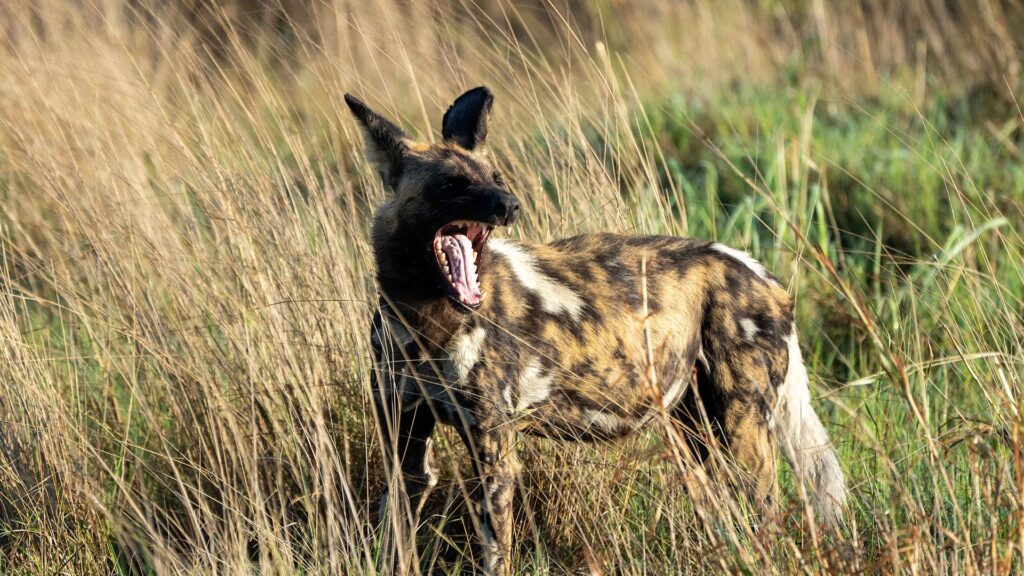
April
During April, the dry season starts and there is a decrease in rainfall and thunderstorms. The temperature ranges from the mid-teens to around 30°C. It is recommended to bring a light fleece for early mornings and evenings during open game drives.
The vegetation remains green and there is an ample amount of surface water, which has led to the dispersion of elephant and buffalo herds in the denser mopane woodlands.
During this time, the resident wildlife, including lions, leopards, wild dogs, and plains animals, can still be observed. It is a great time for photography, with lush green vegetation, clear blue skies, and clean air.
May
May is the start of the dry season, with very little rain. Temperatures decrease, particularly in the early mornings and evenings, necessitating warm clothing.
The camp offers blankets and hot water bottles for cold mornings during early-game drives. The flood waters from the Okavango Delta flow south through the Kalahari sands. The vegetation stays green, and the air is clean.
Animals gather in larger herds at the end of the month. This happens when surface water in the mopane areas dries up. The timing of this movement depends on when the rains ended. Wild dogs start to den during this time. They stay in one area to feed their young pups. This increases the likelihood of seeing them.
The pups are currently in their den and it is advised not to visit them as it may disturb the adult dogs and put the pups at risk from other predators.
June
In early June, animals gather in larger herds. This is because the surface water is drying up. Elephant and buffalo families migrate from the woodlands to Linyanti and Chobe. Wild dogs stay near their dens, which makes it easier to see them. The pups are kept inside the den for their safety.
The vegetation in Moremi Game Reserve is currently green, but it will change later in the month. The skies are clear and the air is dust-free, indicating the peak season.
The weather in the area is dry, with temperatures below 10°C in the mornings and reaching the mid-twenties in the afternoons. It is recommended to bring warm clothing for the cold mornings and evenings. Additionally, the waters in Moremi are replenished by the floods from the Okavango Delta.
High season
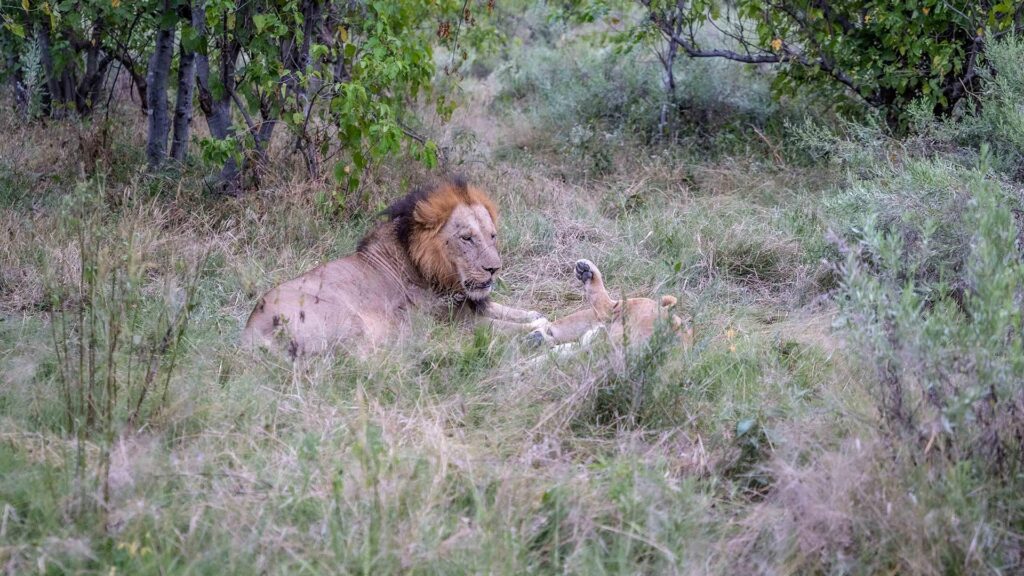
July
During the month of July, the drying up of vegetation and water sources causes an increase in animal populations. As a result, elephants migrate towards the waters of the Moremi Game Reserve.
Predators such as leopards and lions are present in the area. Wild dogs are currently in their dens, but as they mature, they will begin to explore the surrounding area.
The Moremi Game Reserve is known for its diverse habitats, which make it a great place for birding and wildlife sightings. The weather in July is similar to June, with cold mornings and evenings and comfortable days. It is recommended to bring warm clothes for early morning game drives.
Currently, it is the dry season. The vegetation and surface water have dried up. The animal numbers are plentiful. Family herds of elephants are moving north through the Moremi Game Reserve to Linyanti and Chobe. Larger herds of plains animals can be observed on the grasslands and near water sources.
Adult wild dogs are leaving the den now that the pups are old enough to join them. It is probable to spot wild dogs since they do not tend to stray too far. The Moremi Game Reserve is renowned for its plentiful prey species, making it an excellent location for observing wild dogs.
The skies remain blue, however, the air is becoming hazy with dust, resulting in stunning sunsets. Temperatures are increasing, particularly during the day and towards the end of the month.
Temperatures in the Moremi and Khwai Reserves vary between 10°C and 30°C, making layered clothing necessary.
August
August is a popular and busy time to visit these reserves.
Temperatures gradually increase throughout the month, reaching highs of over 30°C. It is advisable to wear layered clothing, particularly at the start of the month. Rainfall is unlikely, and the air may be dusty, resulting in stunning sunsets.
Animals are attracted to the main water channels of the Delta because the surface water is drying up.
Buffalo herds, family herds, lone bull elephants, and plains animals can be observed in the area. Wild dogs are more challenging to find as they travel long distances every day in search of prey.
September
The Moremi and Khwai reserves are known for their abundance of wild dogs, as well as the presence of leopards and lions throughout the year. September is considered an ideal month for game viewing in these reserves due to it being the peak of the dry season.
The weather is extremely hot with little wind. Temperatures range from late teens to over 40°C by the end of the month.
Towards the end of the month, there may be a sprinkle of light rain, slightly cooling things down and clearing the air. The air is generally hazy with dust, creating beautiful African sunsets.
The vegetation is mostly dry, except around rivers and marshes. Only the deepest channels of the rivers have water, as the Kalahari sands soak up the shallow pools and streams.
Surface water is almost non-existent, causing large herds of wildlife to gather around the main water sources. This makes it an excellent time for wildlife sightings.
The wild dogs move constantly within their territory, making them difficult to track. Lions and leopards are present in the area, giving you a good chance of seeing these predators. October, despite the heat, is one of the most rewarding times for wildlife viewing.
November
November is a month of transition from dry season to partial rains. If it rains, it’s usually a short thunderstorm followed by clear skies. Moremi Game Reserve offers great photo opportunities during this time.
Wildlife is abundant, with elephants and buffalos still present before the heavy rains. Once the rains start, herds disperse into thicker woodlands. Resident wildlife remains, making it rewarding for those willing to search. Impalas start giving birth in late November, attracting predators.
Vegetation quickly turns green after the first rains. Temperature varies in November, with highs around 35°C. Rain can cool things down, so bring a fleece or rain jacket. Many consider November as a great time for safaris as the region transforms into a lush green paradise.
December
In December, afternoon thunderstorms become more frequent. They usually last about half an hour and then clear to blue skies. Migrant birds arrive and engage in courtship displays.
Baby impala continue to be preyed upon by wild dogs, lions, leopards, hyenas, and other predators. The larger herds of elephants and buffalo have moved away, but plains animals remain and take advantage of the abundant food and water.
If you’re willing to search harder, this can be a rewarding time for a safari in the Moremi Game Reserve. Daytime temperatures have dropped due to the rains, making it slightly more pleasant although it can still reach a maximum of 35°C.
Activities in the seasons
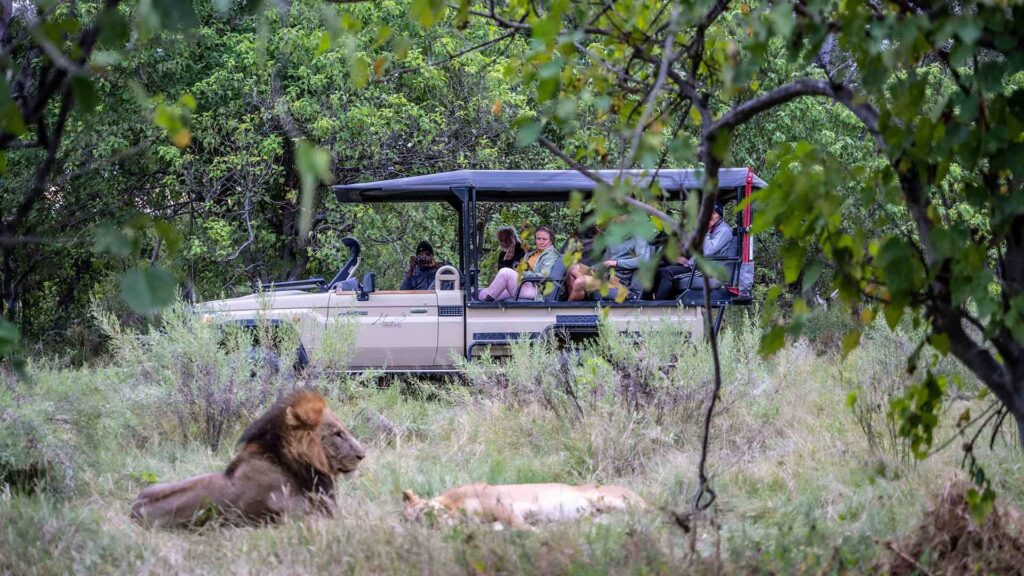
In Moremi, located in Botswana Africa, the water level of the Okavango Delta varies according to the season, which will have a significant impact on the activities available. During months when the water levels are high enough, mokoro (a traditional canoe) excursions become possible and are one of the most sought-after activities by visitors.
Keep in mind that due to climate change, it is becoming increasingly difficult to predict weather patterns, so this should be taken into consideration when planning your visit. Because in Botswana winter falls in May to July, these times present better temperatures to go on walking safaris, especially in Moremi and the Khwai Concession areas.
Meanwhile, when water levels are low, game drives become available and offer an unparalleled opportunity for close interactions with wildlife. Guests will enjoy these once-in-a-lifetime encounters with some of Africa’s most majestic creatures.
No matter what time of year you visit or what activity you choose to participate in – be sure to make the most out of every single moment spent in Moremi because each experience offers something truly fantastic and indescribable.
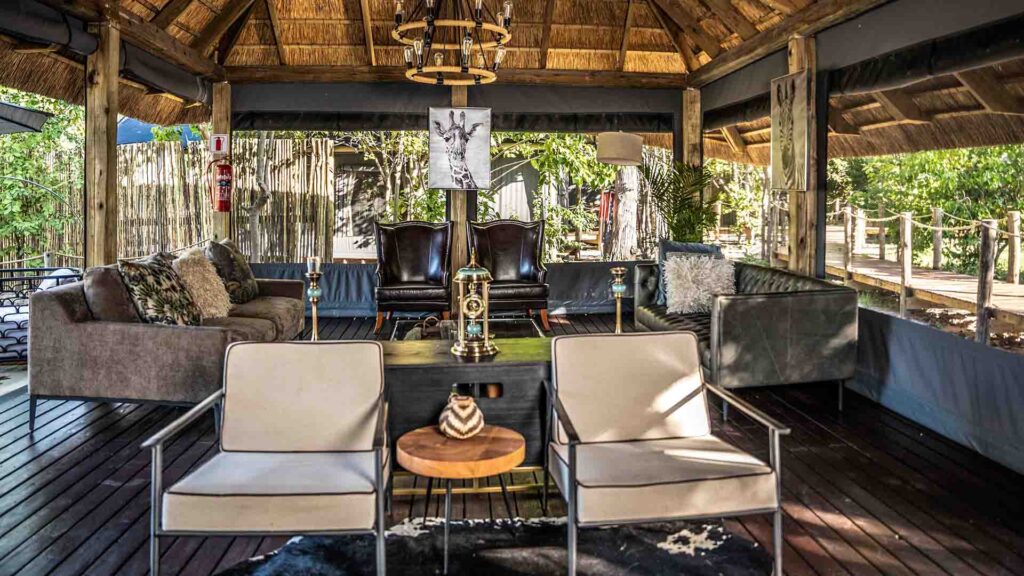
Visit Khwai Expeditions Camp for an Ultimate Moremi Experience
Moremi Game Reserve stands as a testament to Botswana’s commitment to preserving its natural heritage. From the rich biodiversity and conservation initiatives to the diverse safari experiences and cultural encounters, Moremi offers an unmatched journey into the heart of Africa’s wildlife haven.
As you embark on your adventure, remember that in Moremi, every footprint tells a story, and every moment is an opportunity to witness the untamed beauty of the wild.

